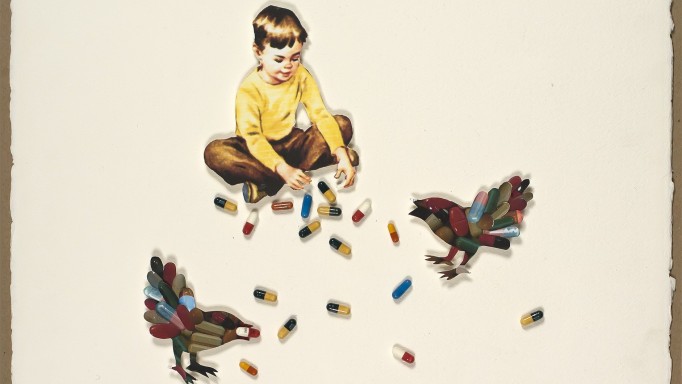CMV belongs to the herpes family of viruses, which also includes herpes zoster (chicken pox, shingles) and herpes simplex (cold sores, genital herpes). About half of all people in industrialized nations are infected with the virus. Almost all gay/bisexual men and more than 75 percent of all people living with HIV carry it.
However, being infected with CMV is no reason to panic. It is only a threat when the immune system is severely weakened. If your CD4 count falls below 50, then you’re at a much greater risk of developing CMV disease, particularly of the eye (see below).
Thankfully, HIV treatment can help protect and repair the immune system, which in turn greatly lowers the risk of developing CMV disease—especially when the CD4 count stays above 100. Also, preventive treatment can be used by people living with HIV who are at risk.
What is CMV disease?
In people living with HIV, CMV can cause disease in one or more parts of the body. Left untreated, these conditions can progress quickly. They include:
- CMV Retinitis: CMV can cause damage to the back of the eye, or the retina. This can lead to blurred vision, blind or moving spots, and blindness. This is the most common type of CMV disease in people living with HIV. While it’s usually not life-threatening, sight problems and blindness are usually permanent even when treatment was successful.
- CMV Encephalitis: CMV can cause damage to the brain. If it reaches the brain and the immune system cannot control it, death can occur within weeks to months. If brain damage is less severe, dementia, confusion, fever and memory problems can occur.
- CMV Radiculopathy: CMV can damage the nerves, which can cause pain or tingling in the limbs, particularly the legs and feet. It can also lead to loss of urinary or bowel movement control.
- CMV Colitis: CMV disease of the colon often has symptoms of abdominal pain, weight loss, diarrhea and cramping. Most forms occur in people with less than 50 CD4 cells. However, CMV colitis has been seen in people with higher CD4 counts, even those on HIV treatment. It is the second most common form of CMV disease.
- CMV Gastritis: This disease of the upper gut, including the stomach, can lead to symptoms like those seen in patients with CMV colitis.
- CMV Esophagitis: This is CMV disease of the throat. It can lead to pain that makes it difficult or impossible to swallow, chest pain and hiccups.
- CMV Pneumonitis: This disease of the lungs is very uncommon but can lead to difficulty breathing.
What are the symptoms?
Symptoms of CMV depend on the organs that are affected. The symptoms of CMV retinitis are different from CMV disease in the gut.
Some of the symptoms of CMV retinitis include:
- Floating spots before the eyes
- Hazy vision, as if looking through a screen
- Blurred or missing areas of vision
Some of the symptoms of CMV in the upper and lower stomach include:
- Debilitating diarrhea
- Loss of appetite
- Tiredness
- Fever
- Blood in the stool
- Stomach cramps
- Weight loss
- Painful swallowing
- Pain in center of the chest
If you have any of these symptoms, contact your doctor immediately.
How is CMV diagnosed?
Again, many people in the United States are already infected with the virus. It only causes disease in those with severely weakened immune systems. And, even if CMV is present and detected by a blood test, it does not mean that the virus will cause active disease.
Diagnosing CMV disease depends on the affected organ. CMV retinitis, for example, can often be diagnosed by an eye doctor, simply by looking at the back of the eye. Other forms of CMV—such as CMV encephalitis, esophagitis, and colitis—are diagnosed by using tissue samples collected from the organ involved.
How is CMV treated?
CMV is treated using powerful antiviral drugs. However, it cannot be cleared from the body—it can only be treated to stop it from causing or worsening disease. At the same time, treating CMV may not reverse the damage that has already occurred.
In most cases, treatment consists of two phases: induction and maintenance. Induction is meant to treat the disease and usually takes 2–3 weeks until symptoms resolve. Maintenance is intended to prevent the disease from returning if the immune system is severely weakened.
Treatment depends on the type and severity of CMV that is present, the CD4 count, a person’s ability to stay on treatment, and possible interactions with other medications that are being taken. HIV treatment is also an important part of CMV treatment. If the person isn’t on treatment, an HIV regimen should be started.
Because most women with HIV are positive for CMV infection before pregnancy, the risk for fetal disease is low provided that active disease is not present. However, fetal transmission can occur during pregnancy if reinfection with another CMV strain or reactivation of the earlier infection occurs. For pregnant women, screening, treating and preventing CMV disease is generally the same as for non-pregnant women. However, to lower the risk of birth defects, the use of oral or IV antiviral drugs should be started in the second trimester if at all possible. Eye injections of antiviral drugs can be given in the first trimester.
Induction treatment:
If the CMV disease in the eye is moderate to severe, the affected eye is usually treated with an injected drug (1–4 injections of ganciclovir or foscarnet over 7–10 days), while systemic treatment is taken (daily oral valganciclovir for at least 14–21 days) to prevent the disease from spreading to the other eye. For people with milder eye lesions, oral valganciclovir may only be needed. (A ganciclovir implant was once used and was very effective; however, it is no longer available.)
Other induction treatment plans for CMV of the eye are also possible. These include giving the injections described above, plus various oral or IV forms of ganciclovir, valganciclovir, foscarnet, or cidofovir + probenecid (not for those with a sulfa allergy) for at least 14–21 days.
If CMV disease is only present outside the eyes, then eye injections are not necessary. Instead, oral and IV forms of CMV drugs are used. Longer treatment may be necessary depending upon how severe the disease is and when symptoms resolve. Treating some forms of CMV such as lung and nerve-related disease have not been well studied.
In some cases, a person may experience immune recovery uveitis (IRU) after first starting HIV treatment when CMV disease is present. This usually occurs only in people who have very rapid and large gains from their initial low CD4 counts. An experienced ophthalmologist can help distinguish IRU from other causes. Symptoms include swelling of the eyes and vision loss. Treatment usually involves using corticosteroid drops.
Maintenance treatment:
Depending upon the sites of CMV disease, maintenance treatment should continue after the induction phase to prevent the disease from returning, especially when the CD4 count is below 100. This should be done in consultation with an ophthalmologist for CMV retinitis. Various drugs can be used for all forms of CMV, including the IV and oral forms of the medications for induction treatment. Eye injections may also be used for maintenance.
Although fomivirsen was once used to treat CMV, it is no longer available in the U.S.
Maintenance treatment can be stopped if the CD4 count rises and stays above 100 for 3–6 months and the CMV lesions have resolved. However, eye exams should continue every three months as a preventive measure at any CD4 count. If the CD4 count goes below 100 again, then maintenance treatment should be restarted.
Can CMV be prevented?
Because CMV is a very easy virus to transmit—it can be spread through saliva and sexual fluids—there is no easy way to prevent from getting it. However, here are ways to prevent CMV from causing active disease and illness:
- Keep your immune system healthy. CMV disease, especially CMV retinitis, can occur once the immune system becomes seriously damaged (CD4 count below 100). HIV treatment can help protect the immune system and, as a result, help prevent CMV from causing disease. However, some cases of CMV have been seen in people with higher CD4 counts.
- See an eye doctor on a regular basis. If you have a suppressed immune system, you should see an ophthalmologist regularly, usually every 3 months. The doctor can examine the back of your eyes for any signs of CMV and recommend treatment before permanent damage occurs.
- Optimal hygiene practices. If you are uninfected, washing hands often and wearing latex gloves during childcare can help reduce the risk of transmission. Always using condoms and not sharing fluids during sex can also help.
Although it was once used as preventive treatment (not maintenance), oral valganciclovir (Valcyte) is no longer recommended by the DHHS. It can cause resistance and there’s a lack of clinical data showing that it prolongs survival in people living with HIV.
Are there any experimental treatments?
If you would like to find out if you are eligible for any clinical trials involving new treatments for CMV, visit ClinicalTrials.gov, a site run by the U.S. National Institutes of Health. The site has information about all HIV-related clinical studies in the United States. For more info, you can call their toll-free number at 1-800-HIV-0440 (1-800-448-0440) or email contactus@aidsinfo.nih.gov.
Last Reviewed: January 24, 2019














